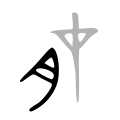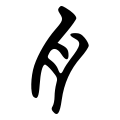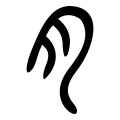Radical 130
| 肉 | ||
|---|---|---|
| ||
| 肉 (U+8089) "meat" | ||
| Pronunciations | ||
| Pinyin: | ròu | |
| Bopomofo: | ㄖㄡˋ | |
| Gwoyeu Romatzyh: | row | |
| Wade–Giles: | jou4 | |
| Cantonese Yale: | yuhk | |
| Jyutping: | juk6 | |
| Japanese Kana: | ジク jiku / ニク niku (on'yomi) しし shishi (kun'yomi) | |
| Sino-Korean: | 육 yuk | |
| Names | ||
| Chinese name(s): | (Left, xin zixing) 月字旁 (⺼) 肉字旁 (⺼) 提肉旁 (Bottom) 肉字底 ròuzìpáng | |
| Japanese name(s): | 肉/にく niku 肉月/にくづき nikuzuki | |
| Hangul: | 고기 gogi | |
| Stroke order animation | ||
 | ||
Radical 130 or radical meat (肉部) meaning "meat" is one of the 29 Kangxi radicals (214 radicals in total) composed of 6 strokes. When used as a left component, the radical character transforms into 月 in Simplified Chinese and Japanese or ⺼ in modern Traditional Chinese used in Hong Kong and Taiwan.
In the Kangxi Dictionary, there are 674 characters (out of 49,030) to be found under this radical.
肉 is also the 132nd indexing component in the Table of Indexing Chinese Character Components predominantly adopted by Simplified Chinese dictionaries published in mainland China.
Evolution[edit]
-
Oracle bone script character
-
Bronze script character
-
Large seal script character
-
Small seal script character
Derived characters[edit]
| Strokes | Characters |
|---|---|
| +0 | 肉 ⺼↔月 |
| +1 | 肊 (=臆) |
| +2 | 肋 肌 肍 肎 (=肯) 肏 |
| +3 | 肐 (=胳) 肑 肒 肓 肔 肕 肖 肗 肘 肙 肚 肛 肜 肝 肞 肟 肠SC (=腸) |
| +4 | 股 肢 肣 肤SC (=膚) 肥 肦 (=頒 -> 頁) 肧 (=胚) 肨 肩 肪 肫 肬 (=疣 -> 疒) 肭 肮SC (=骯 -> 骨) 肯 肰 肱 育 肳 肴SC (=餚 -> 食) 肵 肶 肷 肸 肹 肺 肻 (=肯) 肼 肽 肾SC (=腎) 肿SC (=腫) 胀SC (=脹) 胁SC (=脅) |
| +5 | 朑 胂 胃 胄 胅 胆SC (=膽) 胇 胈 胉 胊 胋 背 胍 胎 胏 胐 胑 (=肢) 胒 胓 胔 胕 胖 胗 胘 胙 胚 胛 胜SC (=勝 -> 力) 胝 胞 胟 胠 胡 胢 胣 胤 胥 胦 胧SC (=朧 -> 月) 胨SC (=腖) 胩 胪SC (=臚) 胫SC (=脛) 胬 脉SC (=脈) |
| +6 | 胭 胮 胯 胰 胱 胲 胳 胴 胵 胶SC (=膠) 胷 (=胸) 胸 胹 胺 胻 胼 能 胾 胿 脀 脁 脂 脃 (=脆) 脄 脅 脆 脇 脈 脊 脋 脌 (=𢆡 -> 乙) 脍SC (=膾) 脎 脏SC (=髒 -> 骨) 脐SC (=臍) 脑SC (=腦) 脒 脓SC (=膿) 脔SC (=臠) |
| +7 | 脕 脖 脗 (=吻 -> 口) 脘 脙 脚SC/JP (=腳) 脛 脜 脝 脞 脟 脠 脡 脢 脣 脤 脥 脦 脧 脨 脩 脪 脫 脬 脭 脮 脯 脰 脱SC/JP (=脫) 脲 脳JP (=腦) 脴 脵 脶SC (=腡) 脷 脸SC (=臉) |
| +8 | 脹 脺 脻 脼 脽 脾 脿 (=膘 / 俵 -> 人 / 婊 -> 女) 腀 腁 (=胼) 腂 腃 腄 腅 腆 腇 腈 腉 腊 (also SC form of 臘) 腋 腌 腍 腎 腏 (=餟 -> 食) 腐 腑 腒 腓 腔 腕 腖 腗 (=脾) 腘SC (=膕) 腙 腚 |
| +9 | 幐 朡 腛 腜 腝 腞 腟 (=膣) 腠 腡 腢 腣 腤 腥 腦 腧 腨 腩 腪 腫 腬 腭SC (=齶 -> 齒) 腮 腯 腰 腱 腲 腳 腴 腵 腶 腷 腸 腹 腺 腻SC (=膩) 腼 腽SC/HK (=膃) 腾SC (=騰 -> 馬) |
| +10 | 腿 膀 膁 膂 膃 膄 膅 膆 膇 膈 膉 膊 膋 膌 膍 膎 膏 膐 (=膂) 膑SC (=臏) |
| +11 | 膒 膓 (=腸) 膔 膕 膖 膗 膘 膙 膚 膛 膜 膝 膞 膟 膠 膡 膢 膣 |
| +12 | 朥 膥 膦 膧 膨 膩 膪 膫 膬 膭 膮 膯 膰 膱 膲 膳 膴 膵 膶 |
| +13 | 膷 膸 膹 膺 膻 膼 膽 膾 膿 臀 臁 臂 臃 臄 臅 臆 臇 臈 臉 臊 臋 (=臀) 臌 |
| +14 | 臍 臎 臏 臐 臑 臒 臓JP (=臟) |
| +15 | 臔 臕 (=膘) 臗 臘 |
| +16 | 臖 臙JP (=胭) 臚 臛 臜SC (=臢) |
| +17 | 臝 (=裸 -> 衣) |
| +18 | 臞 臟 |
| +19 | 臠 臡 臢 |
Variant forms[edit]

This radical character has different forms in different languages when used as a left component. Traditionally, the writing form of the radical character as a left component is hardly distinguishable with Radical 74 (月 "moon"). In the Kangxi Dictionary, 月 which means the "moon" has its two horizontal strokes' right ends detached from the frame, while those in 月 which means "meat" are connected to the frame. In modern Japanese and Simplified Chinese, this difference no longer exists.
In modern Traditional Chinese used in Hong Kong and Taiwan, the two horizontal strokes in 月 meaning "meat" are altered to a dot and an upward horizontal stroke, a change that also applies to printing typefaces despite it historically only being used as a handwriting variant.
Sinogram[edit]
The radical is also used as an independent Chinese character. It is one of the Kyōiku kanji or Kanji taught in elementary school in Japan.[1] It is a second grade kanji[1]
References[edit]
- ^ a b "The Kyoiku Kanji (教育漢字) - Kanshudo". www.kanshudo.com. Archived from the original on March 24, 2022. Retrieved 2023-05-06.
Literature[edit]
- Fazzioli, Edoardo (1987). Chinese calligraphy : from pictograph to ideogram : the history of 214 essential Chinese/Japanese characters. calligraphy by Rebecca Hon Ko. New York: Abbeville Press. ISBN 0-89659-774-1.




